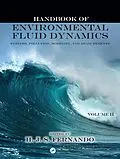With major implications for applied physics, engineering, and the natural and social sciences, the rapidly growing area of environmental fluid dynamics focuses on the interactions of human activities, environment, and fluid motion. A landmark for the field, the two-volume Handbook of Environmental Fluid Dynamics presents the basic principles, funda
Autorentext
Harindra Joseph Shermal Fernando is the Wayne and Diana Murdy Endowed Professor of Engineering and Geosciences at the University of Notre Dame, with the primary affiliation in the Department of Civil and Environmental Engineering and Earth Sciences and a concurrent appointment in the Department of Aerospace and Mechanical Engineering. He has received numerous awards and honors, including a UNESCO Team Gold Medal (1979), Presidential Young Investigator Award (NSF, 1986), and Rieger Foundation Distinguished Scholar Award in Environmental Sciences (2001). He is a fellow of the American Society of Mechanical Engineers, American Physical Society, and American Meteorological Society and was elected to the European Academy in 2009. He serves on the editorial boards of Applied Mechanics Reviews (associate editor), Theoretical and Computational Fluid Dynamics (editor, 1997-), IAHR Journal of Hydro-Environment (associate editor), Physics of Fluids (associate editor) and EGS Journal of Non-Linear Processes in Geophysics (editor). He is also the editor in chief of the Journal of Environmental Fluid Dynamics. Professor Fernando has published more than 225 papers spanning nearly 50 international peer-reviewed journals.
Inhalt
Part I Engineered Systems and Anthropogenic Influence: Water Distribution Systems. Groundwater-Surface Water Discharges. Fluid Mechanics of Agricultural Systems. Desalination and the Environment. Bubble Plumes. Scour around Hydraulic Structures. Flow through Urban Canopies. Flow through Buildings. Bluff Body Aerodynamics and Aeroelasticity. Wake-Structure Interactions. Urban Heat Islands. Part II Environmental Pollution: Atmospheric Dispersion. Flow and Dispersion in Street Canyons. Air Flow through Tunnels. Sound Outdoors and Noise Pollution. Riverine Transport, Mixing, and Dispersion. Ocean Outfalls. Modeling Oil Spills to Mitigate Coastal Pollution. Miscible and Immiscible Pollutants in Subsurface Systems. Part III Numerical Modeling of Environmental Flows: Turbulent Flow Modeling. Direct and Large Eddy Simulation of Environmental Flows. Multiscale Nesting and High Performance Computing. Multiscale Representations. Dispersion Modeling. Modeling the Urban Boundary and Canopy Layers. Air Pollution Modeling and Its Applications. Mathematical Models to Improve Performance of Surface Irrigation Systems. Cyberinfrastructure and Community Environmental Modeling. Uncertainty in Environmental NWP Modeling. Part IV Laboratory Modeling of Environmental Flows: Physical Modeling of Hydraulics and Sediment Transport. Laboratory Modeling. General Laboratory Techniques. Hot-Wire Anemometry in Turbulence Research. Optical Methods and Unconventional Experimental Setups in Turbulence Research. Part V Environmental Measurements: Hydrophysical Measurements in Natural Waters. Flow Measurements in the Atmosphere. Atmospheric Flux Measurements. Clear-Air Radar Profiling of Wind and Turbulence in the Lower Atmosphere. Index.
